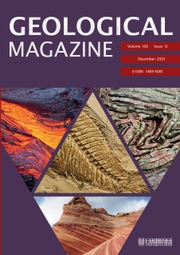Article contents
I.—Notes on the Palæontology of Western Australia
Published online by Cambridge University Press: 01 May 2009
Extract
“Transversely rhomboidal, moderately gibbose, width four times the length; sides flattened, regularly attenuating to the very acute cardinal angles; cardinal area broad, flat; mesial fold wide, defined, angular, smooth; about sixteen to eighteen slightly convex, simple, smooth ribs on each side of the mesial fold, becoming indistinct as they approach the cardinal angles, so as to leave nearly a third of the length of the sides smooth.”
- Type
- Original Articles
- Information
- Copyright
- Copyright © Cambridge University Press 1890
References
page 145 note 1 See Quart. Journ. Geol. Soc. vol. xxviii. 1872, appendix to R. Daintree's Geology of Queenland, by R. Etheridge, F.R.S., p. 335, pl. xvii. fig. 3.
page 146 note 1 See a short paper by F. T. Gregory in Quart. Journ. Geol. Soc. 1861, vol. xvii. p. 475; also the paper by W. H. Hudleston, F.R.S., in the same Journal, 1883, vol. xxxix. p. 582, already referred to.
page 146 note 2 Wissensch. Beobaeht. auf einer Reise in das Petschoialand im Jahre 1843, p. 229, Tab. viii. figs. 2 a—c (1846). See also de Koninck, Faune du Calc. Carb. de la Belgique, 1887 (Ann. du Mus. Roy. d'Hist. Nat. de Belgique, tom. xiv.), pt. vi. p. 108, pl. xxiv. figs. 6, 7, and pl. xxvi. figs. 1—4. Recorded also by Th. Tschernyschew, Allgem. geol. Karte von Russland, Blatt 139 (Mém. du Com. Géol. vol. iii. No. 4), p. 355.
page 147 note 1 This word is written “Moosakhailensis” by Davidson, but I have adopted Waagen's spelling of it (Salt Range Fossils, Pal. Ind.), as being doubtless the more correct one.
page 148 note 1 See table of synonymy.
page 148 note 2 Pal. Ind.—Salt-Range Fossils, 1887, vol. i. p. 512, pl. xlv.
page 148 note 3 Loc. cit. p. 515.
page 149 note 1 Nouv. Mém. de la Soc. Imp. des Nat. de Moscou, 1860, tom. xiii. pl. xxxv. fig. 6d.
page 151 note 1 An explanatory note by Mr. H. P. Woodward to the following effect accompanied these fossils:—“Irwin River, Coal Seam, a little S.E of Champion Bay, about 30 miles from coast: sandy table-land, cut through by river, exposing ferruginous sandstones and conglomerate, resting unconformably on Coal-measure Series.”
page 152 note 1 In Darwin's Geological Observations on Coral Reefs, etc. pt ii. 1851, Appendix, p. 158.
page 152 note 2 Dr. Woodward, H., F.R.S., and Mr. Etheridge, , jun., proved that these figures represent “a distinct and separate species,” from fig. 4c, which is the true P. brachythœrus (Proc. Roy. Phys. Soc. Edinburgh, vol. v. 1880, pp. 286, 287)Google Scholar.
- 4
- Cited by


